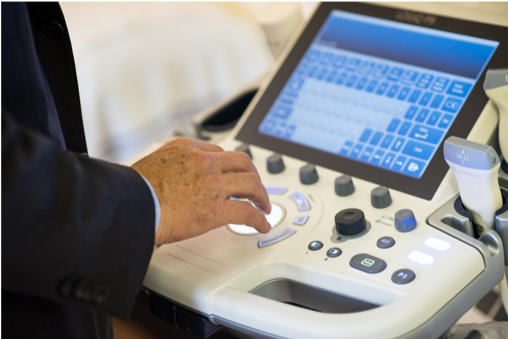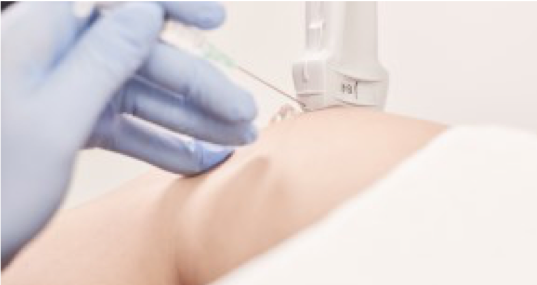
Training pathways for physiotherapists wanting to learn diagnostic ultrasound and ultrasound guided injections
As an Extended Scope Physiotherapist (ESP) and someone who provides ultrasound and ultrasound guided injection courses I am very enthusiastic about other physiotherapists attending our courses and extending their skills. However, if physiotherapists want to start scanning and carrying out injections it is important that they follow the correct training pathway.
I regularly get questions from physiotherapists about the training required to start using diagnostic ultrasound and ultrasound guided injections. This blog aims to answer these questions and provide some clarity around the subject of competency. As always, competency-based questions around ultrasound never have a simple answer.
Question 1: Is diagnostic ultrasound within the scope of practice for physiotherapy and am I insured to carry out scans?
The simple answer is ‘yes’. If you can prove that ultrasound is within your scope of practice then you can carry out diagnostic ultrasound scans as part of your clinical assessment, and you are insured to do so under your normal physiotherapy insurance.
A physiotherapist defines his or her own scope of practice. The CSP defines scope of practice as follows:
“Your individual scope of practice describes the physiotherapy work that you are educated, trained and competent to carry out. This will be unique to you and is influenced by your career, experience and development – CSP Website”
There is no need to add this to your insurance policy and it will not increase your premium. If you are not a member of the CSP and are not insured through the CSP then I would advise you contact your insurer to discuss. But remember: just because you are insured does not mean you are competent. If you are not competent you are not insured. If a case is brought against you then you MUST be able to prove your competency otherwise your insurance is not valid.

A physiotherapist can use diagnostic ultrasound in their clinic to help diagnose MSK complaints, but they must be able to prove their competency. Obviously, it would not be appropriate for physiotherapists to start using diagnostic ultrasound for scanning non–musculoskeletal structures, e.g. pregnancy scanning, ‘lumps and bumps’ or internal organs.
Just attending a course with no assessment process does not prove competency. It takes approximately 9 to 18 months with regular scanning, teaching and supervision to gain a basic level of competency in MSK ultrasound. Like any element of a clinicians practice it is the clinicians responsibility to be able to provide documentation of their training and learning pathway. MSK ultrasound is a very operator-dependent imaging modality with a steep learning curve which takes hundreds of hours to achieve a basic level of competency. Certain elements must be fulfilled to prove competence in MSK ultrasound.
These are:
1. Attend the appropriate courses
2. Spend time observing and scanning with a variety of clinicians from different clinical backgrounds
3. Direct experience and supervision with an adequately trained clinical tutor/supervisor
4. Keep a logbook of scans
5. Audit your scans and reflect on the results/discrepancies
6. Pass a competency-based exam (this does not have to be university accredited)
This should be a continual cycle of learning, reflecting and developing your practise.
For further information I would advise at this point you read my article Training in MSK Ultrasound: How do you become competent? This article is relevant to all professionals from all clinical backgrounds who want to learn MSK ultrasound. The principles of competency are similar whatever your clinical background.
The speed that you gain your ultrasound skills will vary from person to person. There are many reasons for this. Essentially it is a motor skill and some people pick it up quicker than others, just like learning to drive a car or play the guitar. It also depends on your working environment. Access to a machine and the amount of supervision time you get will be one of the biggest factors. For example, if you work in an NHS department surrounded by clinicians who already scan, you will have more opportunities to develop your skills than a sole practitioner working alone in private practice. At the end of the day, like when you learn any new skill, it will come down to your own motivation and the time you can put aside to practise. Practise makes perfect!
If you are looking to learn diagnostic ultrasound, don’t do it alone! Try and seek out other clinicians either in your clinic or in your local area to work alongside. This may be another physiotherapist but can equally be a sports doctor, sonographer, GPwSI, orthopedic surgeon or radiologist. It is far easier if you have someone with whom you can discuss cases and practise (scan each other). It is essential to scan ‘normal’ subjects too at the beginning, and not concentrate just on patients with pathology. Ultrasound scanning is a motor skill and requires hundreds of hours of practise. You need to know what the spectrum of ‘normal’ anatomy looks like to be able to recognise pathology or ‘abnormal’ anatomy. It is important you seek out learning opportunities to observe other clinicians using diagnostic ultrasound in a variety of environments e.g. a sports doctor using it in a private clinic or a radiologist or MSK sonographer carrying their ‘MSK list’. This will give you a broad learning experience and help you to develop your skills and clinical application of ultrasound.
Question 2: How do I train to carry out ultrasound guided injections?
Physiotherapists who have undertaken and passed the adequate training are able to carry out ultrasound guided injections. The key areas we must consider are how do you gain competency in injections and how you obtain the drug.

Competency:
There is currently no agreed competency pathway for any clinicians to carry out ultrasound guided injections. To gain competency we would suggest you attend an accredited postgraduate university-based injection course first. These courses teach ‘unguided’ injection techniques. They provide the theory and practise required to carry out musculoskeletal injections safely and effectively. These courses require you to carry out and log 10 assessed injections. This will require the delegate to obtain a clinical supervisor/assessor. Ten injections is obviously not enough to gain competency in all injections so we suggest you continue with regular mentoring and supervision after you have completed the course, as with any clinical skill.
These courses are currently available at a number of universities, including:

Once you have completed an unguided injection course and have a basic skill level in MSK ultrasound you can then attend our 2-day cadaveric guided injection course. If you are new to scanning, we would advise you attend our Introduction to MSK Imaging to gain a basic level of probe skills before attending our cadaveric guided injection course. This will ensure you gain the most from the cadaveric ultrasound guided injection course which takes place at the world-class facilities of St. George’s Medical School in London.
The course provides the perfect learning environment to practise guided injections. Like any skill practise makes perfect and guided injections are no exception. Delegates are taught all upper and lower limb articular and peri-articular injections over the 2 days and have the opportunity to practise these injections as many times as they like. The course gives you ample practise time on our full-bodied soft-embalmed cadavers (the closest you can get to the real thing!) with close supervision from our expert tutors. We have developed the easiest and most effective techniques for all joint and soft tissue injections. Following the course you will be able to start carrying out ultrasound guided injections in your clinic. However, like the ‘unguided’ injection courses, we advise you carry out and log 10 ‘guided’ injections under supervision.
Essex University has the only university-based course that provides a ‘guided’ injection module. One of our SMUG course tutors, Mark Maybury, an Extended Scope Physiotherapist (ESP), is one of the course leads.
For more information see https://www1.essex.ac.uk/hhs/documents/cpd/hs974-ultrasound-guided-musculoskeletal-injections.pdf
Just a note about physiotherapists working in private practice. To perfect your guided injection skills takes hundreds of injections. I learnt my trade in the NHS and had a ready-made set of clients to refine my skills. In private practice you are unlikely to get enough clients to ‘practise’ on. It could take years to have carried out a hundred guided injections and then it may become difficult to maintain your competency. I would strongly advise if you work in private practice that you try and combine this with at least a part-time NHS role to get the numbers required.
How you obtain the drug:
I recently became an independent prescriber, which as a physiotherapist working solely in private practice has made a significant difference to the client pathway. I would strongly suggest if you are working in private practice and want to carry out ultrasound guided injections that you embark on becoming an independent prescriber. In the future this may be compulsory.
Feel free to email me if you would like further information.
If you are not an independent prescriber, to inject steroid, local anaesthetic or any other prescribed drug you can only obtain the drug through a clinician who has assessed a patient and prescribed them a specific drug at a specific dose for the specific patient. This is known as a Patient Specific Directive (PSD). A PSD is the traditional written instruction signed by a doctor, dentist or non-medical prescriber for medicines to be administered to a named patient.
The other option is a Patient Group Directive (PGD). PGD’s are only an option if you work in the NHS, they do not apply in private practice. A PGD is a written instruction for the administration of medicine to a group of patients e.g. patients with frozen shoulder, who may not be individually identified before presentation for treatment. PGDs essentially provide a legal framework that allows the supply and/or administration of a specified medicine(s) by a named authorised health professional to a pre-defined group of patients needing treatment for a condition described in the PGD, without the need for a prescription or an instruction from a prescriber. Using a PGD is not a form of prescribing. In a busy department this is the most convenient method for both the practitioner and the patient. However, a PGD must be agreed and signed on behalf of the authorising body with which a contract and agreement for the provision of those services has been made. For more extensive information on PGDs here:

Physiotherapists can inject non-prescription injectables such as hyaluronic acid used for osteoarthritis, without the need for a prescription. Hyaluronic acid is classified as a ‘medical device’ not a drug.
For more information on prescribing see: www.csp.org.uk/publications/medicines-prescribing-physiotherapy-4th-edition
Question 3: Am I insured to carry out guided injections?
The next question people always ask is ‘Am I insured to carry out ultrasound guided injections?’. Any clinician carrying out ultrasound guided injections must have the correct insurance. Most physiotherapists get their public liability insurance (PLI) as part of their CSP membership. Your membership covers you to work within your own defined scope of practice. So, if you are insured or not is determined by your ability to prove your competency.

If a case is brought against you then you must be able to prove your competency otherwise your insurance is not valid. Once you have attended the correct courses, passed the assessment process and are deemed competent you must maintain your competency. Competency is a continual cycle of learning, developing and reflecting on your practice.
In conclusion, there are many factors to consider when discussing training pathways and gaining competency in MSK ultrasound and carrying out guided injections. On a personal note, adding these skills to my scope of practice has transformed the way I work and provides a unique one-stop shop to my clients. It has revitalised my enthusiasm for my job and provided many career opportunities that otherwise would not have presented themselves.
I hope you have found this article useful and I hope to see you on one of our courses soon! If you have any questions please do not hesitate to contact Chris Myers (Chartered Physiotherapist & Registered Osteopath) at chris@ultrasoundtraining.co.uk